The adsorption chillers market is expected to grow from USD 215.4 million in 2025 to USD 306.8 million by 2035, owing to rising emphasis on low-energy cooling and industrial waste heat utilization. Key dynamics are being shaped by the increasing pressure on industrial facilities to lower operating emissions and reduce dependence on conventional refrigeration systems that rely on high-GWP refrigerants. Adsorption chillers operate using waste heat, solar heat, or low-temperature thermal energy, making them attractive in chemical processing, food and beverage manufacturing, refinery operations, and district cooling networks. As sustainability-linked operational targets increase, facilities are integrating adsorption chillers to convert previously unused waste heat into productive cooling capacity, improving overall energy efficiency.
During the first half of the forecast period (2025–2030), the market increases to approximately USD 257.1 million, adding USD 41.7 million or 45.6 percent of total projected growth. This phase is characterized by the wider adoption of single-effect chiller systems, which are cost-efficient and suitable for moderate-capacity cooling needs. Performance improvements in silica gel and zeolite adsorbent materials, better heat exchanger configurations, and compact modular system designs are increasing operational reliability. Over the longer term, integration with combined heat and power plants, biomass heating systems, and solar thermal arrays is expected to strengthen market momentum as industrial users prioritize energy reuse, lifecycle cost reduction, and compliance with evolving refrigerant regulations.

The latter half (2030-2035) will witness continued growth from USD 257.1 million to USD 306.8 million, representing an addition of USD 49.7 million or 54.4% of the decade's expansion. This period will be defined by mass market penetration of specialized chiller designs, integration with comprehensive energy management platforms, and seamless compatibility with existing industrial cooling infrastructure. The market trajectory signals fundamental shifts in how manufacturers approach ecological cooling optimization and energy efficiency management, with participants positioned to benefit from constant demand across multiple chiller types and application segments.
The Adsorption Chillers market demonstrates distinct growth phases with varying market characteristics and competitive dynamics. Between 2025 and 2030, the market progresses through its technology adoption phase, expanding from USD 215.4 million to USD 257.1 million with steady annual increments averaging 3.6% growth. This period showcases the transition from basic cooling formulations to advanced single effect systems with enhanced energy efficiency capabilities and integrated waste heat recovery systems becoming mainstream features.
The 2025-2030 phase adds USD 41.7 million to market value, representing 45.6% of total decade expansion. Market maturation factors include standardization of industrial cooling and refrigeration protocols, declining component costs for specialized chiller formulations, and increasing industry awareness of ecological cooling benefits reaching optimal energy efficiency effectiveness in chemical and food processing applications. Competitive landscape evolution during this period features established manufacturers like Hitachi and Johnson Controls expanding their adsorption chiller portfolios while specialty manufacturers focus on advanced technology development and enhanced cooling capabilities.
From 2030 to 2035, market dynamics shift toward advanced energy integration and global industrial expansion, with growth continuing from USD 257.1 million to USD 306.8 million, adding USD 49.7 million or 54.4% of total expansion. This phase transition centers on specialized chiller type systems, integration with automated energy networks, and deployment across diverse chemical and oil and gas scenarios, becoming standard rather than specialized applications. The competitive environment matures with focus shifting from basic cooling capability to comprehensive energy optimization systems and integration with industrial monitoring platforms.
| Metric | Value |
|---|---|
| Market Value (2025) | USD 215.4 million |
| Market Forecast (2035) | USD 306.8 million |
| Growth Rate | 3.6% CAGR |
| Leading Technology | Single Effect Type |
| Primary Application | Chemicals Application Segment |
The market demonstrates strong fundamentals with single effect systems capturing a dominant share through advanced energy efficiency and waste heat utilization optimization capabilities. Chemical applications drive primary demand, supported by increasing industrial cooling and ecological refrigeration technology requirements. Geographic expansion remains concentrated in developed markets with established manufacturing infrastructure, while emerging economies show accelerating adoption rates driven by industrial facility expansion and rising environmental standards.
Market expansion rests on three fundamental shifts driving adoption across the chemicals, food processing, and oil and gas sectors. First, energy efficiency demand creates compelling operational advantages through adsorption chillers that provide immediate cooling capacity and waste heat recovery without compromising operational sustainability, enabling facilities to meet stringent environmental standards while maintaining production productivity and reducing energy consumption. Second, industrial cooling modernization accelerates as manufacturing operations worldwide seek advanced chiller systems that complement traditional refrigeration processes, enabling precise temperature control and energy management that align with industry standards and sustainability regulations.
Third, waste heat utilization enhancement drives adoption from chemical plants and food processors requiring effective cooling solutions that maximize energy efficiency while maintaining operational productivity during process cooling and refrigeration operations. Growth faces headwinds from initial investment cost challenges that vary across chiller suppliers regarding the pricing of advanced adsorption systems and specialty components, which may limit adoption in cost-sensitive environments. Technical limitations also persist regarding cooling capacity constraints and heat source requirements that may reduce effectiveness in low-temperature applications and limited waste heat scenarios, which affect cooling performance and operational requirements.
The adsorption chillers market represents a specialized yet critical cooling opportunity driven by expanding global industrial capacity, energy efficiency modernization, and the need for superior waste heat recovery in diverse manufacturing applications. As facility operators worldwide seek to achieve optimal cooling efficiency, reduce energy costs, and integrate advanced chiller systems with automated platforms, adsorption chillers are evolving from basic cooling equipment to sophisticated energy solutions ensuring operational sustainability and efficiency leadership.
The market's growth trajectory from USD 215.4 million in 2025 to USD 306.8 million by 2035 at a 3.6% CAGR reflects fundamental shifts in industrial energy requirements and ecological cooling optimization. Geographic expansion opportunities are particularly pronounced in Asia Pacific markets, while the dominance of single effect systems and chemical applications provides clear strategic focus areas.
Strengthening the dominant single effect segment through enhanced cooling efficiency, superior waste heat recovery, and automated control systems. This pathway focuses on optimizing energy performance, improving coefficient of performance, extending operational effectiveness to optimal efficiency rates, and developing specialized formulations for diverse applications. Market leadership consolidation through advanced thermal engineering and automated energy integration enables premium positioning while defending competitive advantages against alternative cooling technologies. Expected revenue pool: USD 28-38 million
Rapid chemical manufacturing and industrial facility growth across Asia Pacific creates substantial expansion opportunities through local production capabilities and technology transfer partnerships. Growing industrial investment and government energy efficiency initiatives drive continued demand for advanced chiller systems. Localization strategies reduce import costs, enable faster technical support, and position companies advantageously for procurement programs while accessing growing domestic markets. Expected revenue pool: USD 24-32 million
Expansion within the dominant chemicals segment (estimated 35% market share) through specialized chiller designs addressing process cooling standards and high-capacity requirements. This pathway encompasses continuous process cooling, temperature control integration, and compatibility with diverse chemical manufacturing processes. Premium positioning reflects superior energy efficiency and comprehensive safety compliance supporting modern chemical production. Expected revenue pool: USD 20-27 million
Strategic expansion into food processing applications (estimated 25% market share) requires enhanced cooling capabilities and specialized chiller formulations addressing sanitary operational requirements. This pathway addresses cold storage cooling, process refrigeration, and hygienic designs with advanced thermal engineering for demanding food safety standards. Premium pricing reflects specialized application requirements and extended reliability standards. Expected revenue pool: USD 16-22 million
Development of specialized chiller formulations for oil and gas applications (estimated 20% share) and plastics processing (15%), addressing specific cooling requirements and niche industrial demands. This pathway encompasses offshore platform cooling, refinery process cooling, and cost-effective alternatives for emerging industrial segments. Technology differentiation through proprietary thermal designs enables diversified revenue streams while reducing dependency on single application platforms. Expected revenue pool: USD 14-19 million
Expansion of dual effect segment (estimated 30% market share) through enhanced cooling capacity, premium energy efficiency, and specialized high-performance requirements. This pathway encompasses large-scale industrial applications, combined heat and power integration, and specialty formulations requiring superior thermal characteristics. Market development through advanced cascade engineering enables differentiated positioning while accessing premium markets requiring highest-efficiency cooling solutions. Expected revenue pool: USD 12-16 million
Development of environmentally superior chiller formulations addressing regulatory compliance and sustainability requirements across chemical and food processing applications. This pathway encompasses zero-ODP refrigerants, renewable energy integration, and comprehensive ecological documentation. Premium positioning reflects environmental leadership and sustainability expertise while enabling access to green building procurement programs and sustainability-driven industrial partnerships. Expected revenue pool: USD 10-14 million
Primary Classification: The market segments by type into Single Effect and Dual Effect categories, representing the evolution from basic cooling systems to specialized chiller solutions for comprehensive energy optimization.
Secondary Classification: Application segmentation divides the market into Chemicals, Food Processing, Oil and Gas, Plastics Processing, and Others sectors, reflecting distinct requirements for cooling capacity, temperature ranges, and energy efficiency standards.
Regional Classification: Geographic distribution covers Asia Pacific, Europe, North America, and other regions, with developed markets leading adoption while emerging economies show accelerating growth patterns driven by industrial facility expansion programs.
The segmentation structure reveals technology progression from standard single effect formulations toward specialized dual effect systems with enhanced efficiency and cooling capabilities, while application diversity spans from chemical processing to specialized food and industrial manufacturing applications requiring precise chiller solutions.
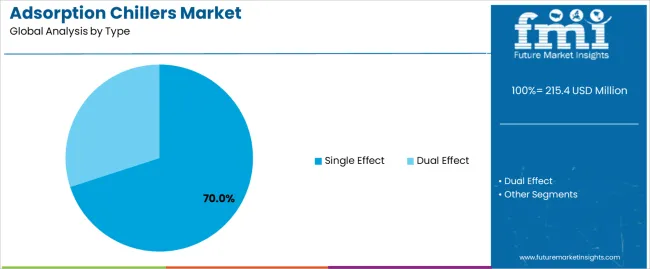
Market Position: Single effect systems command the leading position in the Adsorption Chillers market with approximately 70% market share through advanced cooling technology, including superior waste heat utilization, cost-effective operation capability, and energy optimization that enable facilities to achieve optimal cooling performance across diverse chemical and food processing environments.
Value Drivers: The segment benefits from operator preference for reliable chiller systems that provide consistent cooling capacity, reduced energy consumption, and operational efficiency without requiring high-grade heat sources. Advanced thermal features enable automated temperature control, energy recovery, and integration with existing industrial equipment, where cooling reliability and heat source flexibility represent critical operational requirements.
Competitive Advantages: Single effect systems differentiate through proven energy efficiency, consistent cooling performance, and integration with low-grade waste heat sources that enhance operational effectiveness while maintaining optimal capacity suitable for diverse industrial applications.
Key market characteristics:
Dual effect systems maintain premium cooling positioning in the Adsorption Chillers market due to their enhanced efficiency properties and high-capacity advantages. These systems appeal to facilities requiring sophisticated cooling capabilities with superior performance for large-scale industrial applications. Market adoption is driven by chemical plant expansion, emphasizing high-efficiency cooling solutions and operational excellence through optimized dual effect thermal cycles while maintaining comprehensive energy recovery capabilities.
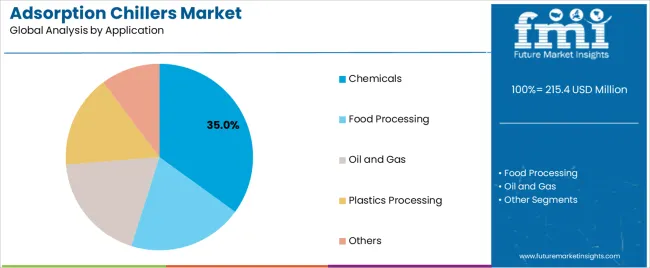
Market Context: Chemical applications dominate the Adsorption Chillers market with approximately 35% market share due to widespread adoption of energy-efficient cooling systems and increasing focus on process temperature control, waste heat recovery, and sustainability management applications that minimize energy costs while maintaining production standards.
Appeal Factors: Chemical manufacturers prioritize cooling reliability, energy efficiency, and integration with existing process infrastructure that enables coordinated chiller deployment across multiple production units. The segment benefits from substantial industrial investment and modernization programs that emphasize the acquisition of adsorption chillers for energy optimization and sustainability applications.
Growth Drivers: Chemical facility expansion programs incorporate adsorption chillers as standard cooling equipment for process operations, while specialty chemical growth increases demand for precise temperature control capabilities that comply with environmental standards and minimize energy consumption.
Market Challenges: Varying chemical industry standards and process temperature differences may limit chiller standardization across different production facilities or operational scenarios.
Application dynamics include:
Food processing applications capture approximately 25% market share through specialized cooling requirements in cold storage facilities, process refrigeration operations, and food manufacturing applications. These facilities demand reliable chiller systems capable of maintaining precise temperatures while providing energy-efficient cooling and ecological operational capabilities.
Oil and gas applications account for approximately 20% market share, plastics processing operations capture 15%, while other segments represent 5%, including data centers, district cooling systems, and specialty manufacturing applications requiring adsorption chiller capabilities for energy optimization and cooling compliance.
Growth Accelerators: Industrial energy efficiency drives primary adoption as adsorption chillers provide superior waste heat utilization capabilities that enable operations to meet stringent sustainability standards without excessive operational costs, supporting production operations and facility missions that require effective process cooling applications. Sustainable cooling infrastructure demand accelerates market expansion as facilities seek effective refrigeration systems that minimize electricity consumption while maintaining operational effectiveness during process cooling and temperature control scenarios. Environmental regulation increases worldwide, creating continued demand for advanced chiller systems that complement traditional cooling processes and provide energy efficiency in competitive markets.
Growth Inhibitors: Initial capital cost challenges vary across chiller suppliers regarding the pricing of advanced adsorption systems and specialty thermal components, which may limit operational flexibility and market penetration in regions with constrained capital budgets or cost-sensitive facility operations. Technical performance limitations persist regarding cooling capacity constraints and heat source temperature requirements that may reduce effectiveness in low-temperature applications, variable load conditions, or facilities with limited waste heat availability, affecting cooling reliability and operational requirements. Market fragmentation across multiple industry standards and cooling configurations creates compatibility concerns between different chiller suppliers and existing industrial infrastructure.
Market Evolution Patterns: Adoption accelerates in chemical processing and large industrial sectors where energy efficiency justifies chiller investment costs, with geographic concentration in developed markets transitioning toward mainstream adoption in emerging economies driven by industrial facility expansion and sustainability awareness. Technology development focuses on enhanced thermal materials, improved cycle efficiency, and compatibility with renewable energy systems that optimize cooling performance and operational effectiveness. The market could face disruption if alternative cooling technologies or electric heat pump innovations significantly limit the deployment of adsorption chillers in industrial applications, though adsorption chillers' unique combination of waste heat utilization, environmental sustainability, and low operating costs continues to make them preferred in process cooling applications.
The Adsorption Chillers market demonstrates varied regional dynamics with Growth Leaders including China (4.8% CAGR) and India (4.5% CAGR) driving expansion through industrial facility capacity additions and energy efficiency programs. Steady Performers encompass Germany (4.1% CAGR), Brazil (3.7% CAGR), and United States (3.4% CAGR), benefiting from established chemical industries and advanced ecological cooling adoption. Mature Markets feature United Kingdom (3% CAGR) and Japan (2.7% CAGR), where specialized industrial applications and energy efficiency integration support consistent growth patterns.
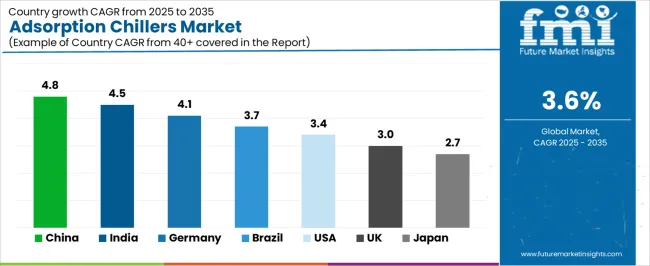
| Country | CAGR (2025-2035) |
|---|---|
| China | 4.8% |
| India | 4.5% |
| Germany | 4.1% |
| Brazil | 3.7% |
| United States | 3.4% |
| United Kingdom | 3% |
| Japan | 2.7% |
Regional synthesis reveals Asia Pacific markets leading adoption through industrial facility expansion and energy efficiency infrastructure development, while European countries maintain steady expansion supported by ecological cooling technology advancement and environmental standardization requirements. North American markets show moderate growth driven by chemical processing applications and energy efficiency integration trends.
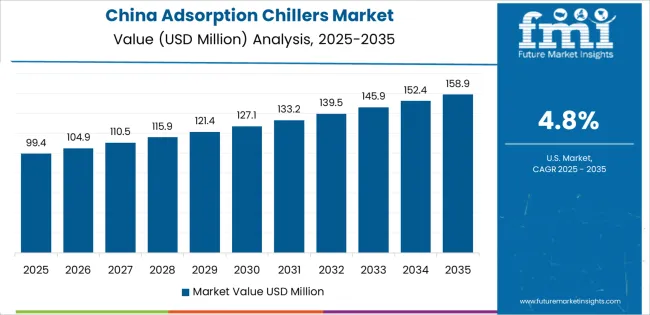
The Chinese market emphasizes advanced cooling features, including precision energy control and integration with comprehensive industrial management platforms that manage cooling quality, efficiency optimization, and thermal applications through unified monitoring systems. The country demonstrates strong growth at 4.8% CAGR, driven by industrial facility modernization, energy infrastructure initiatives, and emerging chemical industry development that support adsorption chiller integration. Chinese manufacturing operations prioritize operational effectiveness with adsorption chillers delivering consistent cooling performance through advanced thermal capabilities and system adaptation features.
Technology deployment channels include major chemical manufacturers, specialized cooling equipment distributors, and industrial procurement programs that support professional applications for complex process cooling and waste heat recovery applications. Industrial platform integration capabilities with established manufacturing systems expand market appeal across diverse operational requirements seeking energy efficiency and cooling benefits. The expanding industrial base and accelerating chemical processing market create continued demand, while innovative applications in district cooling and renewable energy integration open new growth avenues.
Performance Metrics:
Germany's advanced industrial market demonstrates sophisticated adsorption chiller deployment with documented operational effectiveness in chemical processing applications and manufacturing facilities through integration with existing cooling systems and energy infrastructure. The country leverages engineering expertise in ecological technology and energy systems integration to maintain strong growth at 4.1% CAGR. Industrial centers, including Frankfurt, Munich, and Hamburg, showcase premium installations where adsorption chiller systems integrate with comprehensive energy platforms and environmental management systems to optimize industrial operations and cooling effectiveness.
German industrial operations prioritize system efficiency and environmental compliance in chiller development, creating demand for certified cooling systems with advanced features, including renewable energy integration and carbon footprint monitoring. The market benefits from established chemical processing infrastructure and commitment to invest in advanced ecological technologies that provide long-term operational benefits and compliance with EU environmental and energy standards.
Market Intelligence Brief:
The USA adsorption chillers market demonstrates sophisticated deployment across chemical processing applications with documented effectiveness in industrial facilities and food processing operations through integration with comprehensive energy management systems and sustainability infrastructure. The country leverages advanced industrial capabilities in cooling innovation and energy optimization technologies to maintain moderate growth at 3.4% CAGR. Industrial centers, including Texas, Louisiana, and California, showcase premium installations where adsorption chiller systems integrate with comprehensive cooling platforms and automated energy networks to optimize thermal efficiency and operational effectiveness.
American industrial operations prioritize energy reliability and sustainability compliance in chiller development, creating demand for certified systems with advanced features, including smart grid integration and predictive maintenance capabilities. The market benefits from established chemical processing infrastructure and willingness to invest in advanced ecological technologies that provide long-term operational benefits and compliance with EPA and energy efficiency standards.
Market Intelligence Brief:
The UK adsorption chillers market demonstrates advanced sustainability deployment with documented operational effectiveness in chemical processing applications and industrial facilities through integration with existing energy systems and environmental infrastructure. The country leverages industrial expertise in ecological cooling and energy systems integration to maintain steady growth at 3% CAGR. Industrial centers, including London, Manchester, and Birmingham, showcase quality installations where adsorption chiller systems integrate with comprehensive energy platforms and sustainability management systems to optimize environmental compliance and cooling effectiveness.
British industrial operations prioritize system efficiency and regulatory compliance in chiller development, creating demand for certified cooling systems with advanced features, including automated energy monitoring and carbon reporting. The market benefits from established chemical processing infrastructure and commitment to invest in quality ecological technologies that provide long-term operational benefits and compliance with UK and EU environmental standards. Chemical processing applications, food manufacturing operations, and industrial facilities drive diversified demand across multiple application segments.
Strategic Market Indicators:
India's adsorption chillers market demonstrates rapid expansion deployment with documented operational effectiveness in chemical processing applications and industrial facilities through integration with emerging manufacturing systems and energy development infrastructure. The country leverages growing industrial capabilities in cooling technology and energy systems integration to achieve high growth at 4.5% CAGR. Industrial centers, including Mumbai, Ahmedabad, and Chennai, showcase expanding installations where adsorption chiller systems integrate with comprehensive industrial platforms and manufacturing networks to optimize market penetration and cooling effectiveness.
Indian industrial operations prioritize cost-effectiveness and energy standards in chiller development, creating demand for reliable cooling systems with essential features, including basic waste heat recovery and energy monitoring systems. The market benefits from expanding chemical processing infrastructure and willingness to invest in international-standard ecological technologies that provide operational efficiency and compliance with Indian environmental standards.
Market Intelligence Brief:
Brazil's adsorption chillers market demonstrates consistent expansion deployment with documented operational effectiveness in food processing applications and chemical facilities through integration with developing industrial systems and energy infrastructure. The country leverages industrial capabilities in manufacturing operations and processing facilities to maintain steady growth at 3.7% CAGR. Industrial centers, including São Paulo, Rio de Janeiro, and Curitiba, showcase growing installations where adsorption chiller systems integrate with industrial platforms and manufacturing networks to optimize cooling coverage and energy effectiveness.
Brazilian industrial operations prioritize system reliability and operational efficiency in chiller development, creating demand for robust cooling systems with practical features, including simplified maintenance and technical support. The market benefits from expanding food processing infrastructure and industrial investment in ecological technologies that provide operational benefits and compliance with Brazilian environmental standards.
Market Intelligence Brief:
Japan's adsorption chillers market demonstrates precision deployment with documented operational effectiveness in chemical processing applications and industrial facilities through integration with advanced energy systems and quality control infrastructure. The country leverages engineering excellence in precision cooling and energy systems integration to maintain steady growth at 2.7% CAGR. Industrial centers, including Tokyo, Osaka, and Nagoya, showcase premium installations where adsorption chiller systems integrate with comprehensive quality platforms and energy management systems to optimize cooling excellence and operational effectiveness.
Japanese industrial operations prioritize system precision and energy excellence in chiller development, creating demand for ultra-reliable cooling systems with advanced features, including micro-precision temperature control and comprehensive quality integration systems. The market benefits from established chemical processing infrastructure and commitment to invest in highest-quality ecological technologies that provide superior operational performance and compliance with stringent Japanese environmental standards.
Strategic Market Indicators:

The Adsorption Chillers market in Europe is projected to grow substantially over the forecast period, with Germany expected to maintain its leadership position with a significant market share supported by its advanced chemical processing infrastructure and major industrial facilities in Frankfurt and Munich. The United Kingdom follows with strong market presence, driven by comprehensive facility modernization programs and sustainability initiatives. France holds substantial market share through specialized chemical manufacturing activities, food processing operations, and industrial production.
Italy commands notable market presence through strong manufacturing facilities and energy efficiency projects. Spain accounts for growing market share aided by industrial expansion and ecological cooling adoption. The Netherlands maintains steady share driven by specialty chemical operations and district cooling demand. The Rest of Europe region is anticipated to show steady adoption, reflecting consistent growth in Nordic countries, industrial expansion in Central European markets, and facility modernization upgrades across Eastern European chemical processing operations.

In Japan, the Adsorption Chillers market prioritizes single effect systems, which capture the dominant share of chemical processing and industrial cooling installations due to their proven features, including reliable energy optimization and seamless integration with existing industrial infrastructure. Japanese industrial operations emphasize reliability, precision, and long-term operational excellence, creating demand for single effect systems that provide consistent cooling capabilities and superior energy performance based on facility requirements and sustainability standards. Dual effect maintains secondary positions primarily in large-scale chemical applications and high-capacity cooling installations where advanced efficiency functionality meets operational requirements without compromising cooling precision.
Market Characteristics:

In South Korea, the market structure favors international cooling equipment manufacturers, including Hitachi, Johnson Controls, and YORK, which maintain dominant positions through comprehensive product portfolios and established industrial networks supporting both chemical processing cooling and manufacturing facility installations.
These providers offer integrated solutions combining advanced adsorption chiller systems with professional technical services and ongoing maintenance support that appeal to Korean facilities seeking reliable cooling systems. Local equipment distributors and service providers capture moderate market share by providing localized support capabilities and competitive pricing for standard cooling installations, while domestic manufacturers focus on specialized applications and cost-effective solutions tailored to Korean industrial market characteristics.
Channel Insights:
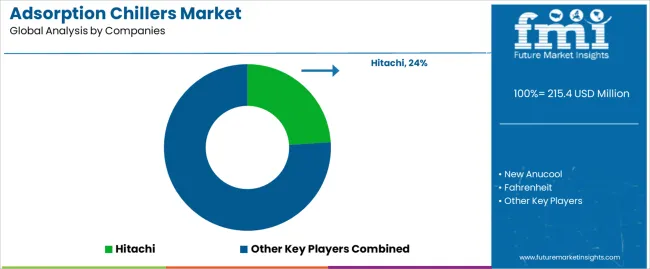
The adsorption chillers market operates with moderate concentration, featuring approximately 18-22 meaningful participants, where leading companies control roughly 50-55% of the global market share through established industrial relationships and comprehensive cooling equipment portfolios. Competition emphasizes advanced energy efficiency capabilities, cooling reliability, and industrial integration rather than price-based rivalry. The leading company, Hitachi, commands approximately 24% market share through its extensive adsorption chiller product line and global industrial cooling presence.
Market Leaders encompass Hitachi, Johnson Controls, and YORK, which maintain competitive advantages through extensive ecological cooling expertise, global industrial networks, and comprehensive energy integration capabilities that create customer loyalty and support premium pricing. These companies leverage decades of thermal technology experience and ongoing innovation investments to develop advanced chiller systems with precision energy control and waste heat recovery features. Technology Innovators include New Anucool, Fahrenheit, and regional specialists, which compete through specialized cooling technology focus and innovative energy capabilities that appeal to facilities seeking advanced ecological solutions and operational optimization.
These companies differentiate through rapid product development cycles and specialized application focus. Regional Specialists feature cooling equipment manufacturers focusing on specific geographic markets and specialized applications, including renewable energy systems and integrated industrial solutions. Market dynamics favor participants that combine reliable cooling performance with advanced energy efficiency capabilities, including precision thermal design and automatic energy management integration features. Competitive pressure intensifies as traditional HVAC equipment suppliers expand into adsorption cooling systems, while specialized ecological technology companies challenge established players through innovative thermal solutions and integrated platforms targeting chemical processing and industrial facility segments.
| Item | Value |
|---|---|
| Quantitative Units | USD 215.4 million |
| Type | Single Effect, Dual Effect |
| Application | Chemicals, Food Processing, Oil and Gas, Plastics Processing, Others |
| Regions Covered | Asia Pacific, Europe, North America, Latin America, Middle East & Africa |
| Countries Covered | China, India, Germany, Brazil, United States, United Kingdom, Japan, and 20+ additional countries |
| Key Companies Profiled | Hitachi, New Anucool, Fahrenheit, Johnson Controls, Inoplex, Berg Chilling Systems, YORK, Thermax, Kawasaki Thermal Engineering, Panasonic, World Energy, M.A.S.A, GOLG, Photon Technology, Shandong Lucy New Energy Technology, Bry-Air, Ebara, Carrier |
| Additional Attributes | Dollar sales by type and application categories, regional adoption trends across Asia Pacific, Europe, and North America, competitive landscape with cooling equipment manufacturers and industrial suppliers, facility preferences for energy efficiency and ecological cooling, integration with industrial platforms and energy monitoring systems, innovations in thermal materials and cooling excellence, and development of automated energy management solutions with enhanced performance and operational optimization capabilities. |
The global adsorption chillers market is estimated to be valued at USD 215.4 million in 2025.
The market size for the adsorption chillers market is projected to reach USD 306.8 million by 2035.
The adsorption chillers market is expected to grow at a 3.6% CAGR between 2025 and 2035.
The key product types in adsorption chillers market are single effect and dual effect.
In terms of application, chemicals segment to command 35.0% share in the adsorption chillers market in 2025.






Full Research Suite comprises of:
Market outlook & trends analysis
Interviews & case studies
Strategic recommendations
Vendor profiles & capabilities analysis
5-year forecasts
8 regions and 60+ country-level data splits
Market segment data splits
12 months of continuous data updates
DELIVERED AS:
PDF EXCEL ONLINE
Adsorption Equipment Market Size and Share Forecast Outlook 2025 to 2035
Immunoadsorption Columns Market Size and Share Forecast Outlook 2025 to 2035
Vacuum Pressure Swing Adsorption Market Size and Share Forecast Outlook 2025 to 2035
Blast Chillers Market Size and Share Forecast Outlook 2025 to 2035
Modular Chillers Market Size and Share Forecast Outlook 2025 to 2035
Beer Glass Chillers Market Size and Share Forecast Outlook 2025 to 2035
Data Center Chillers Market Size and Share Forecast Outlook 2025 to 2035
Instant Wine Chillers & Refreshers Market
Seafood Farming Chillers Market Forecast and Outlook 2025 to 2035
Aquarium Heaters and Chillers Market - Growth & Forecast 2025 to 2035

Thank you!
You will receive an email from our Business Development Manager. Please be sure to check your SPAM/JUNK folder too.
Chat With
MaRIA